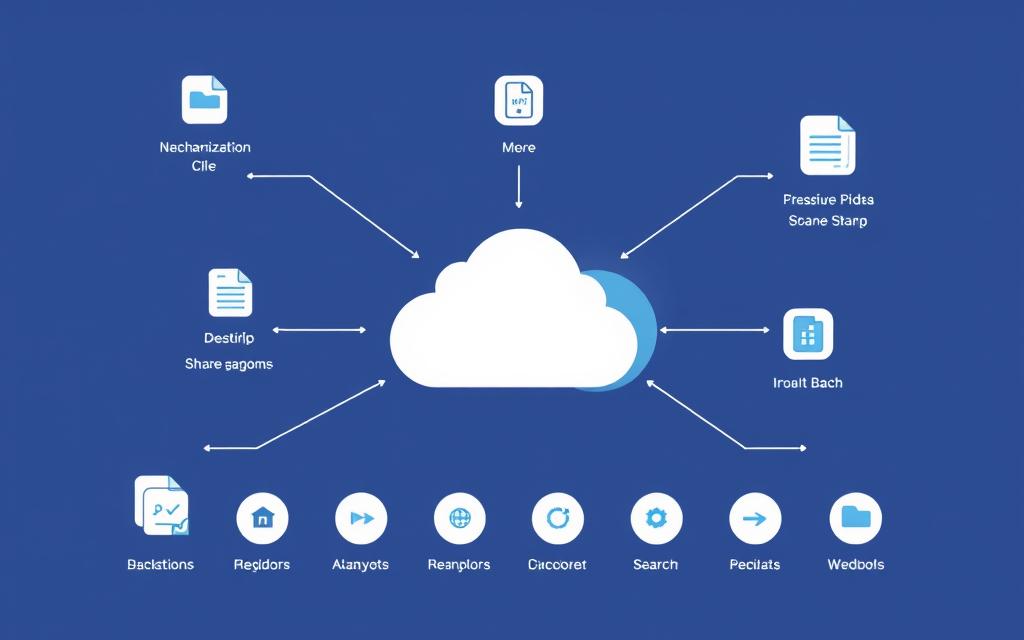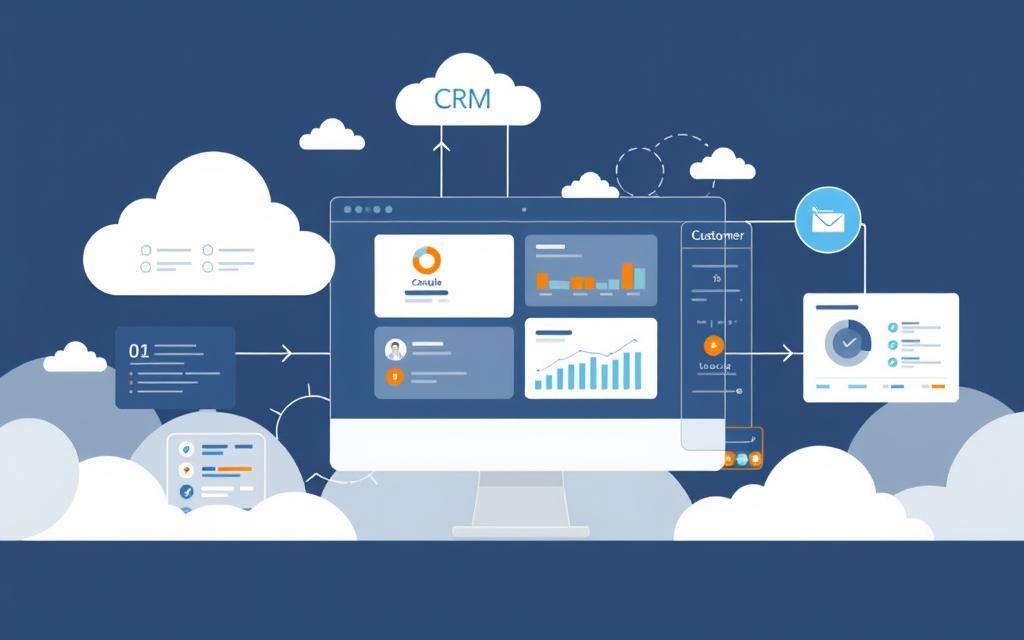Cloud computing has revolutionized the way businesses operate by providing on-demand access to a shared pool of computing resources, including servers, storage, and applications.
By leveraging cloud technology, organizations can scale their infrastructure according to their needs, reducing the need for expensive hardware and enhancing operational efficiency.
The delivery of computing services over the internet enables businesses to access their data and applications from anywhere, fostering greater flexibility and collaboration.
As cloud adoption continues to grow, understanding its definition, working principles, and benefits is crucial for businesses seeking to remain competitive in today’s digital economy.
What is Cloud Technology?
Cloud technology, a paradigm-shifting innovation, has transformed the computing landscape for organizations worldwide. It represents a significant shift from traditional computing paradigms, offering a more flexible, scalable, and efficient way to manage IT resources.
Definition of Cloud Technology
Cloud technology refers to the delivery of computing services over the internet, encompassing a broad range of services including storage, processing power, and applications. Cloud computing enables organizations to access these resources on-demand, reducing the need for capital expenditures on hardware and software. As Forbes notes, “Cloud computing is a model of delivering computing services over the internet, where resources such as servers, storage, databases, software, and applications are provided as a service to users on-demand.”
Brief History and Evolution
The concept of cloud computing has evolved significantly over the years, from its roots in utility computing and virtualization technologies. The term gained popularity in the early 2000s, with major milestones including the launch of Amazon Web Services (AWS) in 2006, followed by Microsoft Azure and Google Cloud Platform. As
“The cloud is a major enabler of digital transformation, providing businesses with the agility and scalability needed to innovate and compete in a rapidly changing market.”
Today, cloud technology is a mainstream computing paradigm, with organizations leveraging it to drive innovation and efficiency.
The evolution of cloud technology has been marked by continuous innovation, with cloud service providers expanding their offerings to include advanced analytics, artificial intelligence, and specialized business applications. This has enabled organizations to adopt cloud technology at an accelerated pace, moving from experimental implementations to enterprise-wide deployments that form the backbone of modern digital business operations.
How Cloud Technology Works
Cloud computing works by leveraging the internet to link users with cloud platforms, where they can utilize a variety of rented computing services.
This connection is facilitated through a complex system of interconnected components, including a central server that handles all communication between client devices and servers to facilitate the exchange of data.
Core Components of Cloud Infrastructure
The cloud infrastructure is composed of several key elements, including servers, storage systems, and networking components. These components work together to provide a robust and scalable platform for delivering services.
| Component | Description |
|---|---|
| Servers | Provide processing power for computing tasks |
| Storage Systems | Store and manage data |
| Networking Components | Enable communication between devices and servers |
The Role of Internet Connectivity
The quality, speed, and reliability of internet connections directly impact the performance and user experience of cloud-based applications and services.
Cloud providers optimize data transmission through techniques like content delivery networks (CDNs), edge computing, and regional data centers to minimize latency and maximize throughput.
“The future of cloud computing is intricately tied to the advancement of internet infrastructure, including fiber optic networks and 5G wireless technology.” – Industry Expert
By understanding how cloud technology works, we can appreciate the critical role that internet connectivity plays in delivering seamless computing experiences to users.

Cloud Deployment Models
Understanding cloud deployment models is crucial for organizations looking to adopt cloud computing. These models determine how cloud services are provisioned, managed, and operated, offering varying degrees of control, flexibility, and scalability.
Public Cloud
A public cloud is a cloud computing environment that is open to the general public and is owned by a third-party provider. Public clouds are multi-tenant, meaning that resources are shared among multiple users. This model is highly scalable and cost-effective, as users only pay for the resources they use.
Public clouds are ideal for businesses that require rapid deployment and scalability. They are particularly useful for applications that are not critical or sensitive, such as web hosting, email services, and collaborative software.
Private Cloud
A private cloud is a cloud computing environment that is provisioned and managed within a single organization. It is typically hosted on-premises or in a dedicated data center. Private clouds offer a high level of control and security, making them suitable for businesses with sensitive data or stringent compliance requirements.
Private clouds can be tailored to meet the specific needs of an organization, providing a customized infrastructure that supports critical applications and data.
Hybrid Cloud
A hybrid cloud combines public and private cloud services, allowing data and applications to be shared between them. This model provides the best of both worlds, enabling businesses to leverage the scalability and cost-effectiveness of public clouds while maintaining the security and control of private clouds.
Hybrid clouds are particularly useful for businesses that require flexibility and agility in their IT infrastructure. They enable organizations to run critical workloads on private infrastructure while using public cloud resources for less sensitive applications or to handle demand spikes.
| Cloud Deployment Model | Description | Key Benefits |
|---|---|---|
| Public Cloud | Multi-tenant, third-party owned | Scalability, Cost-effectiveness |
| Private Cloud | Single-tenant, on-premises or dedicated | Control, Security |
| Hybrid Cloud | Combination of public and private clouds | Flexibility, Agility |
Types of Cloud Computing Services
The flexibility of cloud computing is largely due to its multiple service offerings, each designed to meet specific business requirements. Cloud computing services have transformed the way businesses operate, providing scalable, flexible, and cost-effective solutions.
Infrastructure as a Service (IaaS)
Infrastructure as a Service (IaaS) provides virtualized computing resources over the internet. IaaS offers a range of services including servers, storage, networking, and virtualization.

IaaS allows businesses to scale their infrastructure according to their needs, without the significant upfront capital expenditure. Popular IaaS providers include Amazon Web Services (AWS), Microsoft Azure, and Google Cloud Platform (GCP).
Platform as a Service (PaaS)
Platform as a Service (PaaS) offers a complete development and deployment environment for applications, including tools, libraries, and infrastructure. PaaS enables developers to focus on developing applications without worrying about the underlying infrastructure.

PaaS provides a streamlined process for application development, testing, and deployment. Examples of PaaS include Heroku, Google App Engine, and Microsoft Azure App Service.
Software as a Service (SaaS)
Software as a Service (SaaS) delivers software applications over the internet on a subscription basis. SaaS eliminates the need for businesses to install, maintain, or update software locally.

SaaS applications are accessible from any device with internet connectivity, making them highly flexible. Common SaaS applications include customer relationship management (CRM) tools like Salesforce, productivity suites like Microsoft Office 365, and collaboration tools like Slack.
The benefits of SaaS adoption include predictable subscription-based pricing, automatic updates with new features, cross-platform accessibility, and reduced IT management burden. SaaS has transformed software distribution and consumption models, enabling even small businesses to access enterprise-grade applications.
Key Benefits of Cloud Technology
Cloud computing offers a wide range of benefits that can transform business operations, from cost savings to enhanced flexibility. As organizations continue to adopt cloud technology, they experience significant improvements in various aspects of their operations.
Cost Efficiency and Reduced Capital Expenditure
One of the primary advantages of cloud technology is its ability to reduce capital expenditure. By transitioning to a cloud-based model, businesses can significantly lower their infrastructure costs. The pay-as-you-go pricing model allows companies to only pay for the resources they use, eliminating the need for expensive hardware and software purchases. According to a report, businesses can save up to 30% on their IT costs by adopting cloud services.
Scalability and Flexibility
Cloud technology provides businesses with the scalability and flexibility they need to adapt to changing market conditions. With cloud computing, organizations can quickly scale their resources up or down to meet demand, without having to invest in new infrastructure. This flexibility is particularly beneficial for businesses with fluctuating workloads or those experiencing rapid growth. As noted by experts, “cloud scalability enables businesses to be more agile and responsive to market opportunities.”

Enhanced Security and Disaster Recovery
Cloud providers typically have advanced security measures in place to protect data, including encryption, firewalls, and access controls. This enhanced security reduces the risk of data breaches and cyber-attacks. Additionally, cloud technology enables businesses to implement robust disaster recovery solutions, ensuring that their data is safe and can be quickly restored in the event of an outage or disaster. For instance, a study found that businesses using cloud services experienced a significant reduction in data loss due to improved backup and recovery processes.
Improved Collaboration and Accessibility
With cloud computing, every person in your company has access to data and applications from the devices they already use, anywhere they need it. This accessibility ensures that teams are always up to speed, facilitating faster collaboration and decision-making. The power of cloud computing is further amplified when paired with mobile technology, enabling employees to work from any location with internet connectivity. As a result, businesses can respond more quickly to customer needs and market opportunities. For more information on how cloud technology can enhance business operations, visit TechHack.
In conclusion, the benefits of cloud technology are multifaceted, impacting various aspects of business operations. By adopting cloud services, organizations can achieve cost efficiency, scalability, enhanced security, and improved collaboration. As the business landscape continues to evolve, embracing cloud technology is crucial for staying competitive and achieving long-term success.
Common Business Applications of Cloud Technology
The versatility of cloud computing is evident in its numerous business applications, transforming how companies operate and interact with customers. Cloud technology provides businesses with the flexibility and scalability needed to stay competitive in today’s fast-paced market.
Data Storage and Backup Solutions
Cloud storage solutions offer businesses a secure and efficient way to manage their data. With cloud storage, companies can store and backup their data in a remote, cloud-based environment, reducing the need for on-premise infrastructure.

Business Intelligence and Analytics
Cloud-based business intelligence and analytics tools enable companies to gain valuable insights into their operations and customer behavior. These tools provide real-time data analysis, helping businesses make informed decisions and drive growth.
Customer Relationship Management
Cloud-based Customer Relationship Management (CRM) systems have revolutionized how businesses interact with customers. By centralizing customer data and making it accessible across the organization, cloud CRM solutions enable businesses to create comprehensive customer profiles, support the entire customer journey, and provide insights into customer behavior.
For instance, companies like G Adventures have successfully implemented cloud-based CRM systems, such as Salesforce, to enhance customer relationships and drive business growth. With cloud CRM, businesses can access customer information in real-time, improving responsiveness and customer experience.

Considerations When Adopting Cloud Technology
When adopting cloud technology, organizations must consider several key factors to ensure a successful transition. The shift to cloud computing requires a thorough understanding of the challenges and opportunities it presents.
Security and Compliance Challenges
Adopting cloud technology introduces new security and compliance challenges that organizations must address. Ensuring the security of data in the cloud involves implementing robust security measures, such as encryption and access controls. Organizations must also comply with relevant regulations and standards, such as GDPR and HIPAA, to avoid potential fines and reputational damage. Effective cloud security requires a comprehensive approach that includes data encryption, identity and access management, and continuous monitoring.
- Implementing robust security measures to protect data in the cloud
- Ensuring compliance with relevant regulations and standards
- Conducting regular security audits and risk assessments
Integration with Existing Systems
Integrating cloud services with existing on-premises systems and legacy applications is a complex task that requires careful planning. Organizations can adopt various integration approaches, including API-based integration, middleware solutions, and hybrid connectivity options, to enable seamless information flow between cloud and on-premises environments. Effective integration strategies must balance the need for modernization with the reality of maintaining critical legacy systems.
To simplify the complexity of connecting diverse applications and data sources across hybrid IT landscapes, organizations can leverage integration platforms as a service (iPaaS) and other cloud-native integration tools. Establishing governance frameworks for hybrid environments is also crucial, including policies for data management, security controls, and change management processes.

Conclusion
As organizations continue to navigate the complexities of digital transformation, cloud technology stands out as a pivotal enabler of business success. By adopting cloud computing, businesses can enjoy numerous benefits, including cost efficiency, scalability, and enhanced security. This shift towards cloud technology has transformed the way organizations operate, innovate, and deliver value to their customers. To maximize the benefits of cloud computing, organizations must consider security requirements, compliance obligations, and integration needs. As cloud technology continues to evolve with trends like edge computing and artificial intelligence, businesses can drive growth and stay competitive. Effective cloud adoption is a strategic business choice that can fundamentally transform operations.







